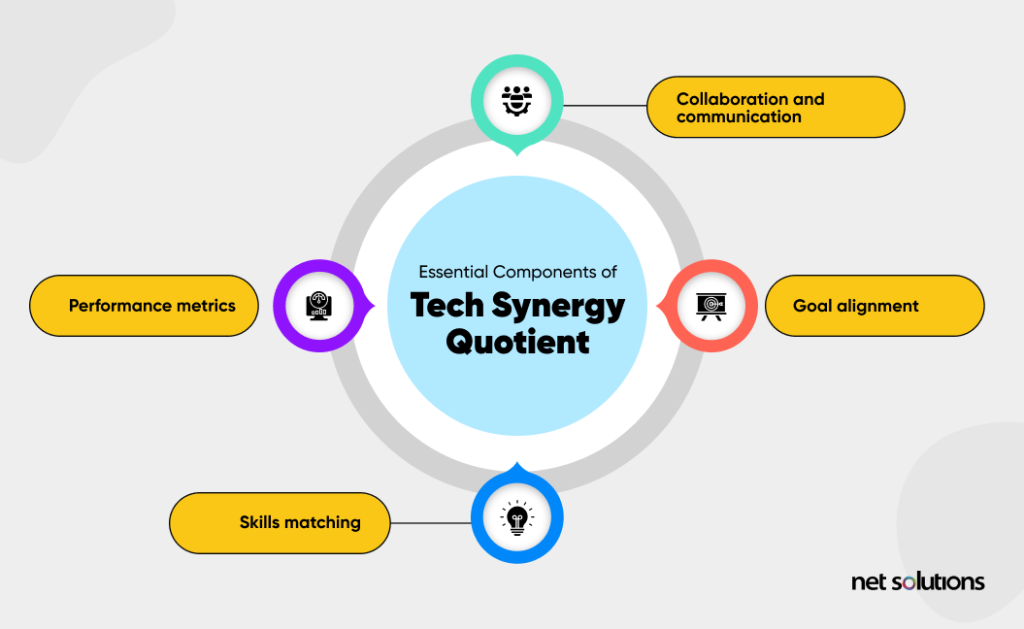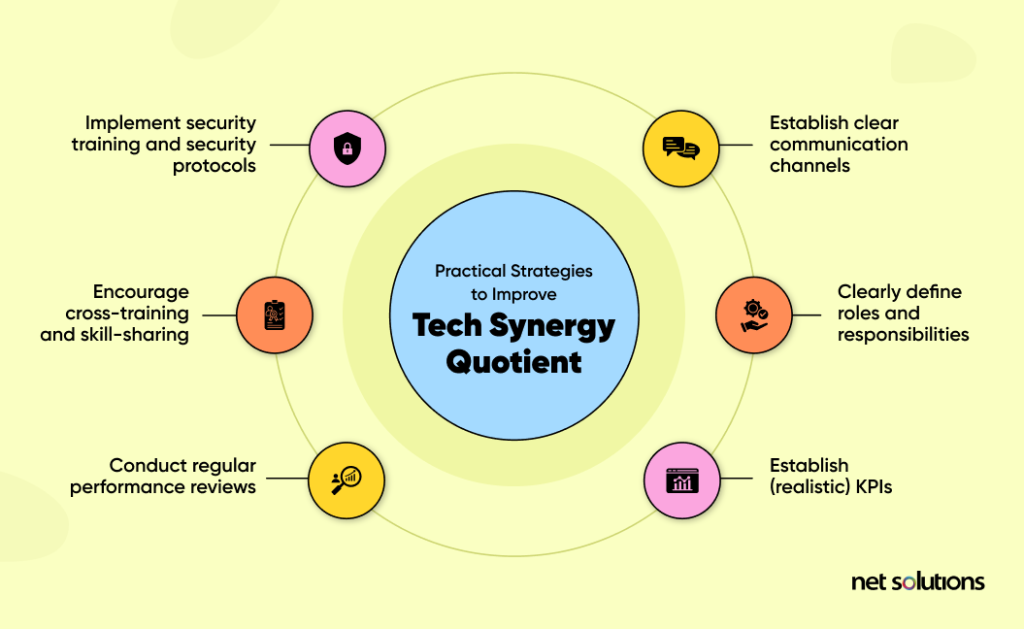Synergy is more than just another business buzzword. Synergy is what happens when a set of teams or companies work effectively and efficiently to produce a result they could not have achieved with harmonious coordination.
Software developers have come up with all sorts of approaches and methodologies to improve synergy and efficiency, such as DevOps, Agile, and others. Each of these tools allows designers, developers, and testers to work in unison to produce better products at a faster pace.
As a means of assessing and improving the synergy between teams and partner companies, we’d like to add to this discussion by introducing a concept we call Tech Synergy Quotient or TSQ.
Let’s discuss what TSQ actually means and explore how it can help you improve your software development outsourcing efforts.
Tech Synergy Quotient (TSQ): What Is It & Why Does It Matter?
Tech Synergy Quotient (TSQ) describes an approach to exploring and addressing a set of teams and their ability to collaborate effectively on IT projects. The concept is especially relevant when exploring how in-house teams can work with outsourcing partners on the other side of the world.
Keep in mind that TSQ is not an actual metric like Net Promoter Score (NPS). There’s no formula to calculate your TSQ. The term is simply a play on the concept of an Intelligent Quotient (IQ). IQ measures general intelligence, whereas TSQ describes—rather than measures—a company or partnership’s ability to collaborate effectively and efficiently.
The concept is becoming increasingly relevant in today’s world of optimization, with 85% of development teams using Agile and nearly all software teams working to maximize their quality and efficiency.
Those companies that have forged partnerships with outsourcing partners should pay close attention to the concept of synergy and give serious thought to their TSQ. Doing so will help them optimize their design and development collaborations.
A clear definition of TSQ
Tech Synergy Quotient (TSQ) is a broad framework for discussing and assessing the capacity of a team, or a group of teams, to collaborate effectively. It promotes alignment, communication, and the optimal allocation of human resources and expertise to produce better software at a faster pace.
TSQ is essentially a way of looking at business processes, expertise, communication, and performance. And while TSQ isn’t a literal metric, you can develop certain Key Performance Indicators (KPIs) to assess the general health of your TSQ—more on that below!
The importance of TSQ
Synergy is essential in today’s global marketplace, especially with distributed teams working around the world. It’s amazing that businesses can tap into talent from across the globe and find experts in any area, but without a concerted effort to produce and maintain synergy between outsourced and in-house teams, creativity and production will suffer.
Focusing on TSQ can help companies and their outsourcing partners:
- Discover new product ideas and tap into deep innovation
- Greatly improve and maintain productivity
- Achieve a faster time-to-market and the competitive advantage that comes with it
- Improve any given project’s overall odds of success
- With this in mind, let’s dive into the essential elements of assessing and improving your TSQ.
Essential Components of Tech Synergy Quotient

What should go into your TSQ assessment? We’ve identified four essential components that will help you review and optimize your TSQ:
- Collaboration and communication
- Goal alignment
- Skills matching
- Performance metrics
Here’s a brief overview of each component. In the next section, we will provide practical strategies to improve each of these areas.
1. Collaboration and communication
Designing and building software products is complex work, even when you’ve got everyone in the same facilities. After all, there are numerous components to every software program that must ultimately work together seamlessly. By the time you’re done translating user feedback to product requirements, things can get messy without clear communication. And the process can only get more convoluted after that!
When it comes to software development teams collaborating on opposite sides of the world, often asynchronously, the potential for miscommunication and rework increases without the right strategy to cultivate communication. The good news is that there are systems you can put in place to greatly improve communication, which we’ll discuss in the strategy section.
2. Goal alignment
Goal alignment is another key element of cultivating a high TSQ. If teams aren’t aligned on the general direction of each new product or release, and they haven’t internalized where the product roadmap is taking them, they’ll struggle to deliver a quality product. When working with an outsourcing partner, whether you’re hiring an entire team to handle a project or using a staff augmentation model, it’s important that anyone working on your project understands the larger goals. They also need to understand the company mission and what matters to your end users.
The goals for any given software development project should be spelled out clearly from the beginning, and product teams derive those goals from user research and feedback. The ultimate mission, of course, is delivering value to your customers. How you accomplish that is the subject of a series of smaller goals tied to each release.
3. Skills matching
To get the most out of a team, or group of teams, it’s important that the right people with the right skills are applied to each task. Carefully consider the skills required for each team and the tasks they face, and consider including a seasoned developer on each team to guide and support the more junior developers.
One of the greatest benefits of working with an outsourcing partner is that you can hire experts in specific areas where your in-house team is underdeveloped. This is helpful because, given the vast array of programming languages that exist today, it’s difficult to master them all.
You probably hired your in-house team for specific skills that they would use on a regular basis. That’s an excellent strategy, but it can leave a skills gap on a given project. Strategically outsourcing those skills to outside talent is an excellent use of resources, especially when they work well in conjunction with your in-house staff.
4. Performance metrics
Measuring synergy is essential to improving it. We’ll dive into specific metrics you can measure that relate to tech synergy below, but know that no assessment is complete without gathering and analyzing data.
You can gather quantitative data through surveys and measuring specific KPIs that evaluate output, efficiency, rework, and other areas. Keep in mind that it’s also important to gather qualitative data by interviewing team members and using open-ended survey questions.
Practical Strategies to Improve Your Tech Synergy Quotient

Now that we’ve established what TSQ is, why it matters, and which factors contribute to a high TSQ, let’s take a look at specific strategies you can explore to improve synergy. Remember to apply these strategies across the board, focusing on both outsourcing partners and in-house IT teams at every step.
1. Establish clear communication channels
Let’s be real, software engineers are not the most extroverted people in the world, and many introverted programmers would prefer to sit at their desks and code all day long. However, modern design and development is a collaborative effort, so here are a few ways you can encourage clear, consistent communication between employees and between entire teams.
- Adopt Agile and DevOps approaches: If you’re not doing so already, letting Agile and DevOps guide your development process encourages regular communication that allows for iteration, improves efficiency, and more.
- Meet regularly via video chat: McKinsey found that you can improve communication among remote teams through regular meetings and systematically addressing any points of confusion or discord.
- Empower team leads: Team leads need to feel empowered to both address communication issues within their team and to communicate challenges to other team leaders.
Make clear communication an integral part of your culture to foster a strong TSQ.
2. Clearly define roles and responsibilities
Clearly defining each person’s role throughout the software development process is key to achieving synergy. Here are a few ways to do that:
- Skills Assessment: Assess each developer’s talents and make sure they’re working on tasks ideally suited to their skill set.
- Creating comprehensive guidelines: Create guidelines for each developer’s role and tasks so nobody is confused about their job.
- Remain flexible: Agile development is all about flexibility, so don’t be afraid to assign new roles and responsibilities to each developer—just be sure to communicate those changes clearly when you do.
Fully utilizing every team member is key to developing and maintaining synergy, and much of that begins with clearly defined roles.
3. Establish (realistic) KPIs
Physicist and Nobel Laureate Richard Feynman famously said: “Science is the art of not fooling yourself, and you are the easiest person to fool.”
Establishing realistic Key Performance Indicators (KPIs) surrounding your efforts to improve synergy will keep you from fooling yourself about those efforts. Here are a few KPIs worth tracking that will give you a sense of how well your teams are working together.
- Rework: Is rework minimized? Some rework is inevitable, but establish a baseline and work to reduce it.
- Efficiency: How quickly are you able to push out each new release? A highly synergistic team has a lower time-to-market than a disorganized one, all things being equal. One good KPI for efficiency is to track story points and see how they stack up against your release burndown chart.
- Code coverage: Code coverage, which is also referred to as test coverage, identifies the amount of source code that executes during testing. Strong code coverage is often a sign of a high TSQ.
This just scratches the surface. There are all kinds of KPIs that allow you to assess the quality of your code and your overall efficiency. Track those that you believe are most connected to tech synergy if you’re looking to boost your TSQ.
4. Conduct regular performance reviews
People can’t change when they have no idea what they need to improve. Regular performance reviews help all employees to change bad habits and develop effective ones.
When conducting performance reviews, be sure to pay particular attention to questions about communication, collaboration, and whether each developer’s skills are being fully utilized.
Of course, when working with an outside team, you won’t be conducting performance reviews for their employees. That’s why it’s essential to communicate with your contact at your outsourcing partner’s office, letting them know what’s working and what needs improvement.
5. Encourage cross-training and skill-sharing
Yes, well-defined and well-suited job roles are essential to improving TSQ, but another key element is flexibility. Job roles change, tasks evolve, and it’s important for developers to share what they’ve learned in each sprint and each project.
Establishing strong synergy for both in-house and remote teams means giving developers the opportunity to learn from each other and cross-train on key roles. This will expand your overall capabilities and reduce downtime when you have to deal with sick leave, vacation, and turnover.
6. Implement security training and security protocols
Security is everyone’s responsibility today, and security protocols are important to adopt at every level and every stage of the software development process.
It all begins with comprehensive security training, but it doesn’t end there. It’s vital to set your standards in place, adhere to best practices, and ensure that everyone is on board.
This is especially important when working with an outsourcing team. Before you sign any contracts, make sure your partners understand and follow the latest and greatest security protocols.
When teams understand and implement cyber security best practices, they aren’t forced to spend time fixing security holes or (even worse) dealing with damage control from an incident. This makes security a key element of a strong TSQ.
Adopt and Apply TSQ to Your Partnerships Starting Today
Synergy is vital when working with an outsourcing partner, whether they’re nearby or on the other side of the world. That’s why we recommend having an in-depth conversation with any potential outsourcing partners around the subject of synergy and determining how much thought they’ve given it.
At Net Solutions, we’ve worked side-by-side with tech teams around the world and served household names, including the Harvard Business Review, Xerox, and Euro Car Parts. We’ve collaborated with our clients to build innovative products and achieve highly efficient output—thanks to a commitment to synergy that is deeply rooted in our approach to software development.




